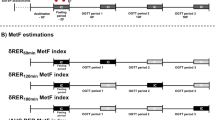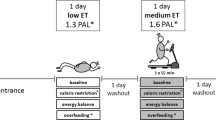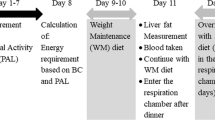Abstract
OBJECTIVE: to assess the impact of obesity and insulin sensitivity on resting (REE) and glucose-induced thermo-genesis (GIT).
DESIGN: Data from 322 studies carried out in non-diabetic subjects of either gender, covering a wide range of age (18–80 y) and body mass index (BMI, 18–50 kg/m2).
MEASUREMENTS: Insulin sensitivity and thermogenesis were measured by combining the euglycaemic insulin clamp technique with indirect calorimetry.
RESULTS: REE was inversely related to age (P=0.001) and the respiratory quotient (P=0.03), and positively related to BMI, lean body mass (LBM), fat mass, and percentage fat mass (all P<0.0001). In a multiple regression model, LBM-adjusted REE was estimated to decline by 9% between 18 and 80 y, independently of obesity and insulin sensitivity. In contrast, GIT was strongly associated with insulin sensitivity (P<0.0001) but not with gender, age or BMI. By multiple regression analysis, GIT was linearly related to insulin sensitivity after controlling for gender, age, BMI and steady-state plasma insulin levels. Furthermore, both of the main components of insulin-mediated glucose disposal (glucose oxidation and glycogen synthesis) correlated with GIT independently of one another. In the subset of subjects (n=89) in whom waist-to-hip ratio (WHR) measurements were available, GIT was inversely associated with WHR (P<0.001 after adjustment by gender, age, BMI, insulin sensitivity and steady-state plasma insulin concentration). In this model, a significant interaction between WHR and gender indicated a stronger adverse effect on GIT of a high WHR in women than in men.
CONCLUSIONS: In healthy humans, age, lean mass and respiratory quotient are the main independent determinants of resting thermogenesis. In contrast, insulin sensitivity and, to a lesser extent, abdominal obesity are the principal factors controlling glucose-induced thermogenesis.
This is a preview of subscription content, access via your institution
Access options
Subscribe to this journal
Receive 12 print issues and online access
$259.00 per year
only $21.58 per issue
Buy this article
- Purchase on Springer Link
- Instant access to full article PDF
Prices may be subject to local taxes which are calculated during checkout
Similar content being viewed by others
Author information
Authors and Affiliations
Consortia
Corresponding author
Rights and permissions
About this article
Cite this article
Camastra, S., Bonora, E., Del Prato, S. et al. Effect of obesity and insulin resistance on resting and glucose-induced thermogenesis in man. Int J Obes 23, 1307–1313 (1999). https://doi.org/10.1038/sj.ijo.0801072
Received:
Revised:
Accepted:
Published:
Issue Date:
DOI: https://doi.org/10.1038/sj.ijo.0801072
Keywords
This article is cited by
-
The impact and distinction of ‘lipid healthy but obese’ and ‘lipid abnormal but not obese’ phenotypes on lumbar disc degeneration in Chinese
Journal of Translational Medicine (2020)
-
Comparison of the effect of ‘metabolically healthy but obese’ and ‘metabolically abnormal but not obese’ phenotypes on development of diabetes and cardiovascular disease in Chinese
Endocrine (2015)
-
A community screening plan for the prevalence of some chronic diseases in specified adult populations in Saudi Arabia: 1- prediabetes and diabetes mellitus
International Journal of Diabetes in Developing Countries (2015)
-
Energy expenditure in obese children with pseudohypoparathyroidism type 1a
International Journal of Obesity (2013)
-
Early and longer term effects of gastric bypass surgery on tissue-specific insulin sensitivity and beta cell function in morbidly obese patients with and without type 2 diabetes
Diabetologia (2011)



